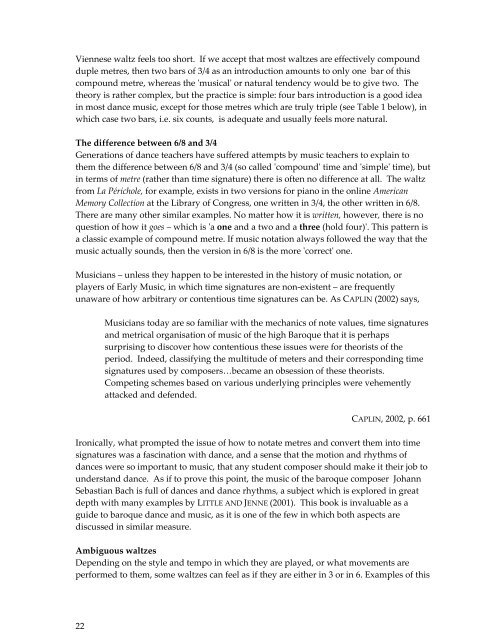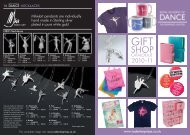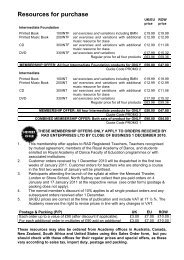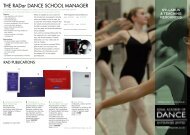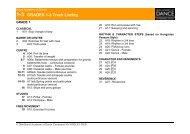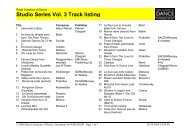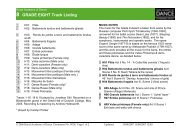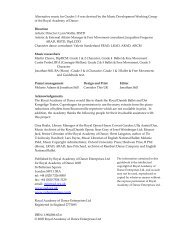to download the guide book in - Royal Academy of Dance Enterprises
to download the guide book in - Royal Academy of Dance Enterprises
to download the guide book in - Royal Academy of Dance Enterprises
Create successful ePaper yourself
Turn your PDF publications into a flip-book with our unique Google optimized e-Paper software.
Viennese waltz feels <strong>to</strong>o short. If we accept that most waltzes are effectively compound<br />
duple metres, <strong>the</strong>n two bars <strong>of</strong> 3/4 as an <strong>in</strong>troduction amounts <strong>to</strong> only one bar <strong>of</strong> this<br />
compound metre, whereas <strong>the</strong> ʹmusicalʹ or natural tendency would be <strong>to</strong> give two. The<br />
<strong>the</strong>ory is ra<strong>the</strong>r complex, but <strong>the</strong> practice is simple: four bars <strong>in</strong>troduction is a good idea<br />
<strong>in</strong> most dance music, except for those metres which are truly triple (see Table 1 below), <strong>in</strong><br />
which case two bars, i.e. six counts, is adequate and usually feels more natural.<br />
The difference between 6/8 and 3/4<br />
Generations <strong>of</strong> dance teachers have suffered attempts by music teachers <strong>to</strong> expla<strong>in</strong> <strong>to</strong><br />
<strong>the</strong>m <strong>the</strong> difference between 6/8 and 3/4 (so called ʹcompoundʹ time and ʹsimpleʹ time), but<br />
<strong>in</strong> terms <strong>of</strong> metre (ra<strong>the</strong>r than time signature) <strong>the</strong>re is <strong>of</strong>ten no difference at all. The waltz<br />
from La Périchole, for example, exists <strong>in</strong> two versions for piano <strong>in</strong> <strong>the</strong> onl<strong>in</strong>e American<br />
Memory Collection at <strong>the</strong> Library <strong>of</strong> Congress, one written <strong>in</strong> 3/4, <strong>the</strong> o<strong>the</strong>r written <strong>in</strong> 6/8.<br />
There are many o<strong>the</strong>r similar examples. No matter how it is written, however, <strong>the</strong>re is no<br />
question <strong>of</strong> how it goes – which is ʹa one and a two and a three (hold four)ʹ. This pattern is<br />
a classic example <strong>of</strong> compound metre. If music notation always followed <strong>the</strong> way that <strong>the</strong><br />
music actually sounds, <strong>the</strong>n <strong>the</strong> version <strong>in</strong> 6/8 is <strong>the</strong> more ʹcorrectʹ one.<br />
Musicians – unless <strong>the</strong>y happen <strong>to</strong> be <strong>in</strong>terested <strong>in</strong> <strong>the</strong> his<strong>to</strong>ry <strong>of</strong> music notation, or<br />
players <strong>of</strong> Early Music, <strong>in</strong> which time signatures are non‐existent – are frequently<br />
unaware <strong>of</strong> how arbitrary or contentious time signatures can be. As CAPLIN (2002) says,<br />
22<br />
Musicians <strong>to</strong>day are so familiar with <strong>the</strong> mechanics <strong>of</strong> note values, time signatures<br />
and metrical organisation <strong>of</strong> music <strong>of</strong> <strong>the</strong> high Baroque that it is perhaps<br />
surpris<strong>in</strong>g <strong>to</strong> discover how contentious <strong>the</strong>se issues were for <strong>the</strong>orists <strong>of</strong> <strong>the</strong><br />
period. Indeed, classify<strong>in</strong>g <strong>the</strong> multitude <strong>of</strong> meters and <strong>the</strong>ir correspond<strong>in</strong>g time<br />
signatures used by composers…became an obsession <strong>of</strong> <strong>the</strong>se <strong>the</strong>orists.<br />
Compet<strong>in</strong>g schemes based on various underly<strong>in</strong>g pr<strong>in</strong>ciples were vehemently<br />
attacked and defended.<br />
CAPLIN, 2002, p. 661<br />
Ironically, what prompted <strong>the</strong> issue <strong>of</strong> how <strong>to</strong> notate metres and convert <strong>the</strong>m <strong>in</strong><strong>to</strong> time<br />
signatures was a fasc<strong>in</strong>ation with dance, and a sense that <strong>the</strong> motion and rhythms <strong>of</strong><br />
dances were so important <strong>to</strong> music, that any student composer should make it <strong>the</strong>ir job <strong>to</strong><br />
understand dance. As if <strong>to</strong> prove this po<strong>in</strong>t, <strong>the</strong> music <strong>of</strong> <strong>the</strong> baroque composer Johann<br />
Sebastian Bach is full <strong>of</strong> dances and dance rhythms, a subject which is explored <strong>in</strong> great<br />
depth with many examples by LITTLE AND JENNE (2001). This <strong>book</strong> is <strong>in</strong>valuable as a<br />
<strong>guide</strong> <strong>to</strong> baroque dance and music, as it is one <strong>of</strong> <strong>the</strong> few <strong>in</strong> which both aspects are<br />
discussed <strong>in</strong> similar measure.<br />
Ambiguous waltzes<br />
Depend<strong>in</strong>g on <strong>the</strong> style and tempo <strong>in</strong> which <strong>the</strong>y are played, or what movements are<br />
performed <strong>to</strong> <strong>the</strong>m, some waltzes can feel as if <strong>the</strong>y are ei<strong>the</strong>r <strong>in</strong> 3 or <strong>in</strong> 6. Examples <strong>of</strong> this


